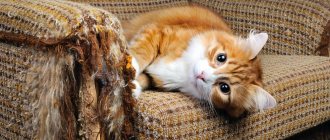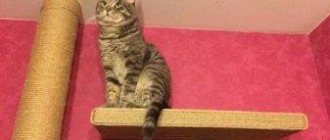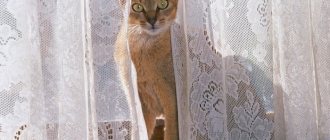Why do cats sharpen their claws?
There are many reasons explaining the natural behavior of representatives of the feline family:
- Physiology. The claws are constantly growing, and over time the old nail plate is replaced by a new, sharper and stronger one. During this, the animal experiences discomfort and inconvenience, as hangnails may form on the paws. To get rid of unpleasant sensations and to speed up the process of changing claws, cats sharpen them on what they consider to be fairly hard surfaces.
- Cats fight for territory. Veterinarians and zoologists say that the tips of a cat's paw pads contain sweat glands necessary for unique scent marks. Thus, the cat makes it clear that he is the boss here.
- This is a kind of fitness to maintain physical shape. While sharpening its claws, the cat uses many muscles, thereby subjecting them to considerable stress.
- Fighting stress. Perhaps damaged furniture and tattered wallpaper are the result of a nervous shock the cat has experienced, or he is simply trying to attract your attention.
What to do if nothing helps
To solve the problem, if it cannot be solved in other ways, you can use another option that involves unexpected loud sounds to scare away.
Go to radical methods if conventional ones do not help.
Such a factor could be:
- a loud dissatisfied shout: “You can’t!”, “Scram!”;
- the sound of a store-bought rattle;
- use a homemade “scarer” made from a tin can with a handful of coins placed in it.
Use claw covers.
Some people advise using inflated balloons to block the road to a forbidden place. However, not everyone approves of this method, so the choice is up to the owner.
Cats' Favorite Surfaces
Probably, upholstered furniture most often suffers from cat claws. It is not for nothing that cats choose armchairs, poufs or sofas as victims; their choice is not accidental. If the animal lives in a natural environment, the main accessory for manicure procedures is tree bark; in an apartment, the cat has no choice but to use an alternative option - upholstered furniture.
In addition, purrs do not mind testing window curtains, carpets, cabinet furniture facades, etc. for strength. There are also surfaces that cats are not interested in:
- ceramic tile;
- stone;
- plaster;
- plastic;
- linoleum;
- parquet;
- laminate and others.
Unfortunately, the materials listed are not used to make furniture, so your furnishings are still at risk. To somehow protect the upholstery or hide existing damage, you can use protective covers or restore the furniture. Next, we will talk about methods that allow you to wean a cat from tearing up furniture and are aimed at re-educating it.
Why do cats tear wallpaper and furniture?
There are many reasons that encourage cats to tear up wallpaper and furniture. Most often, pets damage the owner’s property in order to:
- Maintain claws in “working” condition. Having reached a certain length, cat nails begin to peel off. And scratching hard objects is the only way to remove the dying layer from the claws.
- Stretch your muscles. When a cat pulls wallpaper and furniture, it stretches out completely. This kind of “exercise” is one of the few ways to stretch your paws and body. But only cats that spend their entire lives in an apartment do this. Pets that walk outside for a long time use trees as scratching posts and do not have the habit of jumping on walls or scratching furniture.
- Mark the territory. A cat has glands between its toes that produce a special secretion. And when a pet tears up furniture and wallpaper, it leaves its smell on them. Most often, this problem is faced by owners of several animals that do not get along with each other. But even if there is only one pet living in the house, he can pick up the scent of other cats from the street. Sensing a stranger, the animal becomes restless and begins to tear the wallpaper near the front door or scratch the curtains.
- Get out of a stressful state. Cats often tear up wallpaper and furniture to relieve nervous tension caused by moving, lack of attention from the owner, or the arrival of a new family member. When stressed, cats may not only scratch the wallpaper or the sofa, but also begin to walk past the litter box.
On a note. Very often, the habit of tearing wallpaper and furniture is the result of poor care or lack of education. The little kitten does not yet understand what can and cannot be done. And if he is not stopped in time from stripping walls and furniture upholstery, then undesirable behavior will become ingrained in him.
Spray bottle in the fight against cat claws
You can try to stop your cat from scratching the sofa using a regular spray bottle filled with clean water.
It is a well-known fact that representatives of the cat breed do not like water and avoid contact with it in every possible way. This can be used in the fight to preserve the normal appearance of your apartment. As soon as the purr decides to sharpen its claws on your favorite sofa, direct a stream of water at it and thoroughly wet the scoundrel.
Advantages of the method:
- works after systematic punishment;
- does not require the purchase of special devices;
- does not come with any costs.
Minuses:
- the technique is effective only when you record the cat’s intention and immediately punish it;
- As soon as the smart cat is left unwatched, he will continue his dirty deed without delay.
Repellers
How to stop a cat from scratching furniture and walls? This question is very relevant for everyone who has a purr. You can scare the animal at the moment when it approaches its favorite place and is about to get down to business. Make a rattle using a tin can or nylon bottle filled with pebbles. Start rattling next to the animal only at the moment when it releases its claws, but not before, and especially not after. The cat must understand why it gets this unpleasant sound!
You can use balloons. Every time your cat begins to sharpen her claws, pop a ball next to her. As soon as the purr begins to recognize this object and is afraid of it, hang the balls in all the places where the pussy scratches its claws.
Cats don't like strong scents - we use this against them
If spraying with cold water does not bring results, you need to look for a new effective method that will help bring some sense to the animal. Many breeders use scents in this matter, for example, a bright citrus aroma.
In some cases, it is enough to put a slice of lemon next to your favorite place for manicure and the cat will not repeat his old mistakes for a long time, leaving his favorite carpet alone. You can use citrus essential oils, but under no circumstances apply them to the damaged area, so that you don’t have to figure out how to remove the resulting stains. Specialized veterinary stores have special repellent sprays and fumigators:
Pros:
- efficiency 99.9%.
Minuses:
- aroma traps will have to be constantly updated, since natural odors quickly disappear.
Other methods of raising a pet
Try using other methods - it is quite possible that one of them will help bring your cat to reason.
- Aerosol . Let’s immediately make a reservation about the dubiousness of this option, since usually mustachioed people still continue to scratch furniture treated with special sprays.
I recommend: Table of kitten weight by month
Declawing cats is not a cosmetic procedure, not a “pedicure,” but a serious operation during which the phalanges of the fingers are amputated
What not to do
Most people do not know that their prohibitions and threats do not apply to cats. The animal will always do what it wants, without taking into account your opinion. Therefore, when weaning Vaska from a bad habit, remember some important points.
Owners of cats who exercise daily are lucky in this regard, because any tree is a large scratching post, for the use of which no one will swear.
Video – How to stop a cat from sharpening its claws on furniture
Scotch tape will help preserve furniture
If for some reason the previous two methods did not work or did not suit you, try retraining the cat using regular double-sided tape.
The fact is that cats really don’t like it when their paws stick to something, so they won’t sharpen their claws on a sticky surface. To test this method in practice, stick a sufficient amount of tape to the damaged side of the furniture, curtain, or window sill.
Pros:
- the cat will not want to deal with the unpleasant sticky surface and will lose interest in it;
Minuses:
- Because of the sticky tape, the interior will, of course, not benefit; you will have to endure some inconveniences until the bad habit is eradicated.
Sticky surfaces
How to stop a cat from scratching the sofa? Just let it stick once or twice! Attach double-sided tape to the upholstery. As soon as the animal approaches to scratch its favorite place, it will immediately stick its paw or fur on its side. Cats hate being clingy, so you won't need a lot of lessons.
Place the tape in all places where the cat sticks its claws - the window sill, corners, doors, and so on. Soon the animal will avoid dangerous places three meters away!
Trimming or declawing
You can get your favorite furry manicure done at a pet beauty salon, use the services of a groomer or veterinarian, or try to master a simple procedure yourself at home. For this you will need a nail clipper.
One of the simplest answers to the question of how to stop a cat from scratching furniture with its claws is help with manicure. If you decide to carry out the manipulation yourself, be patient, ask someone to hold the animal, act with extreme caution so as not to injure the delicate skin of the pet.
Those who have repeatedly unsuccessfully tried to wean a cat from the harmful habit of ruining an apartment often use a drastic remedy to prevent the cat from tearing up the furniture - declawing. From a common sense point of view, this is a barbaric procedure, as a result of which your animal will lose an important part of its body, will not be able to walk outside, will not be able to protect itself from the enemy and will be forced to go through a long rehabilitation period.
Important points
When purchasing a scratching post, add a few drops of valerian or motherwort to it (they attract cats). The scratching post should:
- match the pet’s height;
- be securely fastened and withstand pressure from the animal;
- be of medium degree of hardness and roughness.
When choosing a spray, make sure that it does not cause an allergy in your purr. It is best to have your nails trimmed by a veterinarian at first. If you trim the nail too much, you can damage nearby blood vessels, cause an infection, or at least cause pain to your pet.
If you don’t know how to stop a cat from scratching furniture, don’t forget to use traditional methods:
- say “no” or “no” sharply and loudly;
- lightly spray your pet with water from a spray bottle (this will not harm, but it will be unpleasant for the animal).
How to stop a cat from scratching furniture and wallpaper? Use scents. Felines do not like the smell of citrus fruits, onions and vinegar. Dilute citrus oil with water and spray the liquid onto the damaged areas.
Install a scratching post at home
To preserve the original appearance of upholstered furniture, manufacturers of veterinary products have come up with special scratching posts that purrs can use for their intended purpose, without fear of being punished. Veterinarians and breeders recommend accustoming your kitten to a useful device from childhood, so you can be sure that the sofa and other upholstered furniture will definitely not interest the fluffy one.
The choice of scratching posts in the pet store is huge:
- in the form of a house or play complex;
- corners for protecting corners of furniture, connecting walls;
- in the form of a straight board, wave;
- in the form of a column.
These can be floor or wall structures, simplified products in the form of fabric-upholstered boards, or multifunctional houses with a sleeping area and several play compartments. Scratching posts are made from different materials; sesal, jute, natural wood, and carpet are used in production. Whatever option you choose, the main thing is to accustom the cat to it as early as possible. This can be achieved by using a variety of treats to attract attention, including catnip treats.
You can also apply special products to the surface of the scratching post to correct the behavior of the fluffy.
Buy a scratching post
Of course, the simplest solution to direct the natural need of a pet “in a peaceful direction” is to purchase a scratching post. To train your pet to use a scratching post, first place it near the place where he scratches the furniture, and then gradually move the device to the desired location. You can also take the cat by the paws and run them along the scratching post. If the cat responded correctly to your efforts and began to use the scratching post for its intended purpose, be sure to praise and encourage it.
As an option, you can make a scratching post with your own hands: for example, tightly wrap a board with sisal rope or place a small log in the interior.
How to stop your cat from scratching furniture using alternative methods
If you have tried all of the listed methods in your arsenal and none of them have proven effective, you need to try alternative methods of combating a bad cat habit:
- Try putting special anti-scratch guards on the cunning pest's claws. Each claw is fitted with a silicone attachment, which is attached to the surface of the claw with glue, which prevents accidental removal of the accessory.
- Furniture covers. To protect your favorite bed, new sofa or comfortable chair in which you like to drink hot tea and watch the evening news from the merciless claws, you can buy protective furniture covers, the material of which will not be of interest to the four-legged pest.
- Considering that cats choose only certain materials for sharpening their claws, you can replace the damaged material with something that will not arouse the purr's interest. So, in place of the destroyed wallpaper, you can put tiles or cover it with plastic panels.
- Try not to leave your cat alone with an object that she mistook for a scratching post; raising pets has not yet been canceled.
Unlike surgical declawing, the pet does not experience pain or significant discomfort, quickly gets used to the changes and eventually stops paying attention to the attachments. The only thing a cat with such a manicure cannot do is jump to a considerable height and damage your furniture, which means that the goal can be considered achieved. After the claws grow back, you will have to repeat the procedure of gluing new pads.
Making a scratching post with your own hands. Master Class
Let's look at one simple and inexpensive way to make a cat simulator. To do this, prepare in advance:
The post is attached to the center of the base
Painting nylon rope
The rope must dry well
The post is wrapped with rope
Step 5. Secure the second end of the rope on top with the same stapler, and cover the remaining area with a plastic cover. In the absence of the latter, simply paint the area or decorate it as you wish.
The remaining area is covered with a lid
Step 6. The scratching post is ready for use! If you don’t have the time/energy/desire to make this option, you can try making another one (step-by-step instructions are given below).
Photo of the finished scratching post
Table. Making a scratching post from corrugated cardboard.
As a result, you will get something like this scratching post. As you can see, there is nothing complicated here; the work can be completed in just a couple of hours.
DIY scratching post for cats
DIY scratching post in the shape of a fish
General tips or how to stop a cat from tearing up furniture
Do not forget that representatives of the cat family are very smart and resourceful. To retrain an animal, you will have to “have a heart-to-heart talk with it,” be affectionate and attentive, carefully pointing out errors in behavior.
Aggression and physical punishment do not lead to a positive result; it causes stress in the pet and only aggravates the situation. As for education, you need to adhere to the following principles:
- make sure that the cat does not experience stress, surround it with love and sincere care;
- set the boundaries of what is permitted and do not allow them to be crossed;
- Do not hit a defenseless animal, this is a form of cruelty and is absolutely unacceptable.
We talked about how to wean a cat from tearing up a sofa and other interior items, and dwelled in detail on popular methods of combating a bad habit. You just have to choose which of these options you will use.
Check out the toys, teasers, and treats that will keep your furry pets occupied:
Silicone claw pads
This is a relatively new method to protect your home from the restless paws of purring cats. Today there are simply incredibly beautiful overlays for cat claws; any fashionista will envy their manicure! The downside of this method is that it is a bit expensive and not entirely simple. Special caps must be placed on the claws using glue that is safe for the animal. Every few weeks you will have to remove the false claws, file down the real ones, and glue the caps back on.
At first, the cat will feel some discomfort, even though the caps are almost weightless. But soon the fashionista will get used to it and stop paying attention to her paws.
There is one more disadvantage: some too smart individuals quickly realize that everything that can be put on can be taken off! As soon as they learn to do this, they will quickly get rid of their manicure and go blissfully scratch their claws on the sofa.
How to stop a cat from scratching furniture, doors and other things? If none of the previous options are suitable, then we suggest considering others, but not all of them are as humane.
How to avoid mistakes
Many people, when they get a small kitten, perceive it as a living toy, imagining that keeping it will not cause any problems. But when the baby begins to misbehave: he spoils the wallpaper with his claws or “combs” the upholstered furniture, they begin to punish the fluffy, who, oddly enough, becomes more and more naughty day by day and causes more and more damage to the environment.
If your cat has already chosen a piece of furniture or a piece of wall for a claw point, you need to protect this place.
If someone has this exact perception of a cat, it is better not to get one at all. The handsome tailed cat needs to be educated from the first days of his life, and if the time for education is lost, then he needs to be re-educated. To do this, be patient, don’t get angry and don’t punish the baby.
A cat pulls wallpaper much more often if its claws are long enough and it catches on everything.
In order not to raise a small cat into a big egoist and not turn into his slave, it is worth familiarizing yourself with the methods of proper handling of cats. The owner must help the baby learn order, calmly and purposefully.
In nature, cats sharpen their claws on a tree trunk, thus marking their territory.
In addition, it is worth familiarizing yourself with the experience of other owners who highlight the most significant mistakes in raising four-legged animals and not repeating them:
- You cannot punish an animal;
- You should stop trimming your nails yourself and contact a veterinarian for help;
- It is better to keep the old scratching post - the animal may not like the new one, but it is better to place it at the front door or near the bed;
- If the scratching post still needs to be replaced, then objects should be placed next to it that will distract the fluffy’s attention from his destructive actions.
Cats often damage furniture in the house.











